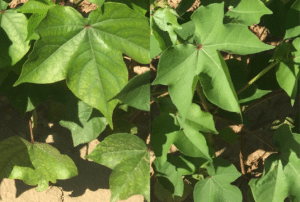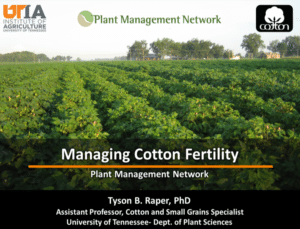Properly managing cotton fertility is an important step in maximizing the efficiency and productivity of all cotton production systems; mismanagement by either over- or under-applying a given nutrient can result in yield penalties and substantial increases in expenses. This year has been no exception- K deficiencies are present in many West TN cotton fields (see adjacent image) and sulfur deficiencies are appearing sporadically as well (see July 6th 2016 article on our modified recommendations). Although I’ve only seen a few areas which are currently deficient in N, it is a safe bet that the number of areas deficient in N and most other nutrients will increase as we move into boll fill.

In order to address these topics, I recently put together a short presentation for the Plant Management Network entitled, “Managing Cotton Fertility.”
Currently available online, this presentation lays the framework for establishing an effective, productive fertility management program- a framework which should benefit all consultants, county agents, growers, and other clientele involved in the cotton industry. Specific topics addressed in this presentation include the importance of managing optimum soil pH, the 4 Rs of nutrient management, and the importance/response, deficiency characteristics, timing/management considerations, and current recommendations for nitrogen, potassium, sulfur and boron.


